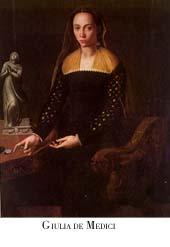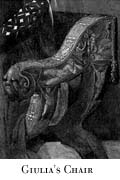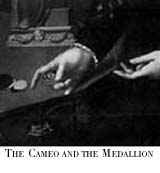

Read the November 2001 Washington Post article on the race issue controversy over a portrait of Giulia.
 Along with her father Alessandro de Medici's uniquely racial place in history,
Giulia de Medici's portrait could also prove of some importance since an
apologia for her blackness forms the basis of the iconographical elements
of the painting. Due more than likely to Giulia de Medici's social position as
a princess and the descendant of a number of popes, whoever assisted the artist
with the symbolism he used obtained it from the Neo platonic concept of God as
Divine Darkness still current in the theology of the time. Probably the most
readily available exposition of this particularly Franciscan brand of mysticism
was St. Bonaventure's Itenarium mentis in Deum orThe Soul's Journey
to God. To fully appreciate the symbolism that was attempted in this
portrait it should be pointed out that the Medici were in religious state
matters, officially devoted to St. Francis.
Along with her father Alessandro de Medici's uniquely racial place in history,
Giulia de Medici's portrait could also prove of some importance since an
apologia for her blackness forms the basis of the iconographical elements
of the painting. Due more than likely to Giulia de Medici's social position as
a princess and the descendant of a number of popes, whoever assisted the artist
with the symbolism he used obtained it from the Neo platonic concept of God as
Divine Darkness still current in the theology of the time. Probably the most
readily available exposition of this particularly Franciscan brand of mysticism
was St. Bonaventure's Itenarium mentis in Deum orThe Soul's Journey
to God. To fully appreciate the symbolism that was attempted in this
portrait it should be pointed out that the Medici were in religious state
matters, officially devoted to St. Francis.
Behind Giulia on her left can be seen an ornately carved chair of state. In an 1982 article,
Gabrielle Langdon, a Canadian art scholar, pointed out the artist had
used the incline of the armrest to depict upwardly sloping terrain. She explained that the
climbing figure she was able to discern with the help of x-ray equipment, had been meant as the
spiritual aspect of the comparatively larger sleeping figure, which is a representation
of Hercules. Professor Langdon maintains the scene is an allusion to the Choice of Hercules, a
popular Renaissance allegory illustrating the hero on the upward path to Virtue as he disdains
the attraction of Vice.
Returning to a more overtly Christian reading, it would also appear that a mountain, Monte la
Verna, is in fact, also being alluded to. This geographical spot, after all, is
precisely where St. Bonaventure received the inspiration to write his Itenerarium.
The reason for the Saint's visit to Monte la Verna was that
this was where St. Francis, during a vision of a crucified six-winged Seraph,
had become a stigmatic by miraculously acquiring the wounds of Christ.
 From the anecdotes regarding Alessandro's blackness and how opposition political
factions tried throwing it in his face, the epithet that
apparently most upset him was da Collavechio. Since moro would not have
been as insulting back in the 16th century before the Battle of Lepanto, the
fact that his mother, Simonetta, had subsequently married a mule driver from
Collavechio was, instead, used to great advantage by his enemies who would
taunt him as Alessandro da Collavechio. I do not think, therefore, that it
would be reaching too far to suggest that some kind of parallelism is to be
understood between colla vechio or the old hill and Monte la
Verna or the Mount of Spring or New Mount. Is Giulia not
pointing to the theological speculation of God as Divine Darkness or Blackness
associated with the latter Monte as some kind of justification or defense of
the ethnic definition of her grandmother so inextricably tied to the former
hill? I would be surprised if she isn't.
From the anecdotes regarding Alessandro's blackness and how opposition political
factions tried throwing it in his face, the epithet that
apparently most upset him was da Collavechio. Since moro would not have
been as insulting back in the 16th century before the Battle of Lepanto, the
fact that his mother, Simonetta, had subsequently married a mule driver from
Collavechio was, instead, used to great advantage by his enemies who would
taunt him as Alessandro da Collavechio. I do not think, therefore, that it
would be reaching too far to suggest that some kind of parallelism is to be
understood between colla vechio or the old hill and Monte la
Verna or the Mount of Spring or New Mount. Is Giulia not
pointing to the theological speculation of God as Divine Darkness or Blackness
associated with the latter Monte as some kind of justification or defense of
the ethnic definition of her grandmother so inextricably tied to the former
hill? I would be surprised if she isn't.
 The six wings of the seraph became for St. Bonaventure, the six stages of the
journey through which the soul must progress. To the Renaissance mentality so
infatuated with Greco Roman imagery, the cameo of Mercury who also has six
wings: two on his heels, the two of his caduceus or staff and the pair on his
helmet is, therefore, a classical reference to the Seraph of St. Francis. Dr.
Langdon's supposition that the medal of Bacchus Giulia so instructively point
to is a Neo platonic allusion is not only accurate, it is the key to
understanding the iconographical program around which this portrait was painted.
The patristic source of St. Bonaventure's ideas is none other than Dionysius
the Aereopagite. Dionysius, considering Giulia's African ancestry, is
extremely important since he is one of the earliest of the Church's teachers to
describe God as the...Ineffable and Divine Darkness. Since Bacchus is
simply the Roman version of the Greek Dionysius, the medallion is obviously
meant to remind the viewer of the beatific vision which is the goal, the very
objective of every soul as explained in St. Bonaventure's "Itenerarium."
The six wings of the seraph became for St. Bonaventure, the six stages of the
journey through which the soul must progress. To the Renaissance mentality so
infatuated with Greco Roman imagery, the cameo of Mercury who also has six
wings: two on his heels, the two of his caduceus or staff and the pair on his
helmet is, therefore, a classical reference to the Seraph of St. Francis. Dr.
Langdon's supposition that the medal of Bacchus Giulia so instructively point
to is a Neo platonic allusion is not only accurate, it is the key to
understanding the iconographical program around which this portrait was painted.
The patristic source of St. Bonaventure's ideas is none other than Dionysius
the Aereopagite. Dionysius, considering Giulia's African ancestry, is
extremely important since he is one of the earliest of the Church's teachers to
describe God as the...Ineffable and Divine Darkness. Since Bacchus is
simply the Roman version of the Greek Dionysius, the medallion is obviously
meant to remind the viewer of the beatific vision which is the goal, the very
objective of every soul as explained in St. Bonaventure's "Itenerarium."
In summary, this painting offers a surprising theological way of thinking about
blackness (just as more Aristotelian references to God have reinforced
archetypes of whiteness since the Age of Enlightenment.) As one of the first
persons of colour in modern history whose response to racism has been recorded,
Giulia de Medici's magisterial pronouncement is of utmost importance to those
of us in the new world who are still suffering from the results of this ugly
social phenomenon. Furthermore, because of Giulia de Medici's relation to the
centers of temporal and spiritual power at the time, the defense she prepared
for herself was the most authoritative. She employed a Neo platonic premise
which is canonically irreproachable even by those standards which are adhered
to by the most conservative curriculum advisers today. Furthermore, whatever
interest is triggered by the theological mysticism that informs this painting,
it should not create the kind of academic controversy more Afro Centric ideas
tend to provoke. For like St. Bonaventure's "Itenerarium" which is the key to
this particular painting by Allori, there are centuries of western religious
speculation that evolved precisely along these lines.
This portrait of Giulia de Medici could easily become in the field of Black
Studies, a very significant work. Instead of being simply a portrait of an
Italian princess whose identity as a quadroon is interesting, it shows her
breathtaking reaction to whatever apprehensions she might have felt regarding
her African descent With whatever theological authority she can claim, she
reminds her contemporaries that God, in His Ineffable Unknowability, is also
Black.
Written and Researched by Mario de Valdes y Cocom an historian of the African
diaspora.
|